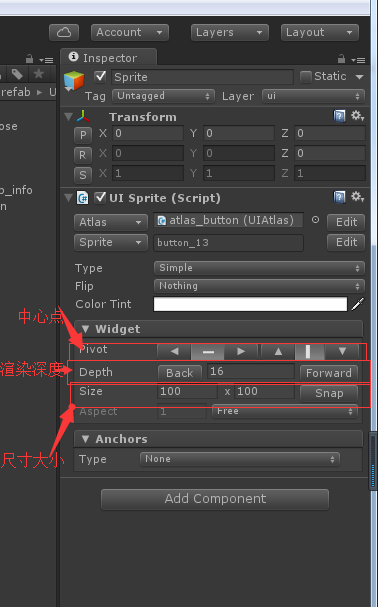【Unity3D NGUI】----UI尺寸和位置的调整
1 尺寸与位置
通过UIWidget类获取,该类是所有UI元素的基类
在unity中创建一个sprite,如下图所示

这里面这个sprite的大小受几个属性的影响,首先是属性面板里的Size,对应的UIWidget成员为width和height字段,然后是其上层节点和自身scale属性。
1.1 局部大小
public override Vector3[] worldCorners { get { Vector2 offset = pivotOffset; float x0 = -offset.x * mWidth; float y0 = -offset.y * mHeight; float x1 = x0 + mWidth; float y1 = y0 + mHeight; Transform wt = cachedTransform; mCorners[0] = wt.TransformPoint(x0, y0, 0f); mCorners[1] = wt.TransformPoint(x0, y1, 0f); mCorners[2] = wt.TransformPoint(x1, y1, 0f); mCorners[3] = wt.TransformPoint(x1, y0, 0f); return mCorners; } }
从上面可以看出局部角点对应的矩形宽和长就等于width和height(mWidth等于width)
1.2 世界坐标系大小
所以计算某个UI元素在屏幕上的真实大小应该为
public override Vector3[] worldCorners { get { Vector2 offset = pivotOffset; float x0 = -offset.x * mWidth; float y0 = -offset.y * mHeight; float x1 = x0 + mWidth; float y1 = y0 + mHeight; Transform wt = cachedTransform; mCorners[0] = wt.TransformPoint(x0, y0, 0f); mCorners[1] = wt.TransformPoint(x0, y1, 0f); mCorners[2] = wt.TransformPoint(x1, y1, 0f); mCorners[3] = wt.TransformPoint(x1, y0, 0f); return mCorners; } }
从里面取两个四个角点之间的距离即可算出真实的大小(因为Transform类获取不到derived scale属性,只能获取到localScale属性)
上面代码中也用到了pivotOffset,该属性对应于在编辑器选中UI元素局部坐标系的原点,默认的情况下该值是(0.5,0.5),表示在UIWidget中的中心,为(0,0)表示在左下角,(1,1)表示在右上角。
同时根据上面的worldCorners也很好获取该UI元素在屏幕上的位置。这里面世界位置的计算中,可以看出同时用到了定义UI元素时的大小、坐标中心,以及该UI元素的转置矩阵。
所以说,假如需要改变UI元素的位置,只需改变其转置矩阵里的位置即可。
1.3 相对于其他元素的位置
采用通用的计算过程,即假如要计算B相对于A的位置,只需给出A和B的世界坐标PA和PB,那么B相对于A的位置即为 Rba = PB- PA。
NGUI里对应的代码如下:
public override Vector3[] GetSides (Transform relativeTo) { Vector2 offset = pivotOffset; float x0 = -offset.x * mWidth; float y0 = -offset.y * mHeight; float x1 = x0 + mWidth; float y1 = y0 + mHeight; float cx = (x0 + x1) * 0.5f; float cy = (y0 + y1) * 0.5f; Transform trans = cachedTransform; mCorners[0] = trans.TransformPoint(x0, cy, 0f); mCorners[1] = trans.TransformPoint(cx, y1, 0f); mCorners[2] = trans.TransformPoint(x1, cy, 0f); mCorners[3] = trans.TransformPoint(cx, y0, 0f); if (relativeTo != null) { for (int i = 0; i < 4; ++i) mCorners[i] = relativeTo.InverseTransformPoint(mCorners[i]); } return mCorners; }
1.4 屏幕位置
上面讨论的位置均是3D空间的位置,而非屏幕上的位置。
要获取一个UI元素在屏幕上的位置,使用NGUI的摄像头将世界坐标转换到屏幕坐标
pt=UICamera.currentCamera.WorldToScreenPoint(pt);
对于置于世界原点的摄像机,它的光轴也穿过世界原点,假如使用
Vector3 screenPt = cam.WorldToScreenPoint(new Vector3(0,0,cam.nearClipPlane);
来计算光轴中心点在屏幕上的位置,可以发现算出来的屏幕位置也为屏幕中心,即(Screen.width/2,Screen.height/2,cam.nearClipPlane);
在NGUI中,2DUI的摄像机是正交摄像机,3D的才是透视摄像机。
同时正交摄像机中
屏幕的右上角对应的世界坐标为:
Vector3 worldPt = cam.ScreenToWorldPoint(newVector3(Screen.width,Screen.height,uiCam.nearClipPlane));
//worldPt = (cam.size*(Screen.width/Screen.height),cam.size,cam.nearClipPlane);
左下角的世界坐标为:
Vector3 worldPt1 = cam.ScreenToWorldPoint(newVector3(0,0,uiCam.nearClipPlane));
//worldPt = (-cam.size*(Screen.width/Screen.height),-cam.size,cam.nearClipPlane);
这里面假设的是相机填满整个屏幕,即相机的Rect属性的w和h均为1
2 实例
2.1 将UI移动屏幕指定像素位置
usingUnityEngine; usingSystem.Collections; publicclassSetPos:MonoBehaviour { publicint targetX; publicint targetY; public Camera uiCam; private UIWidget ui; voidStart() { ui=GetComponent<UIWidget>(); SetScreenPosition(targetX, targetY); } voidSetScreenPosition(int x,int y) { Vector3 targetPos = uiCam.ScreenToWorldPoint(newVector3(x, y, transform.position.z)); Vector3 dir = targetPos - transform.position; transform.Translate(dir); } voidSetScreenPosition1(int x,int y) { //使用线性映射计算目标位置 float w =Screen.width; float h =Screen.height; float posX = uiCam.orthographicSize* w / h; float posY = uiCam.orthographicSize; float targetX = x *2* posX / w - posX; float targetY = y *2* posY / h - posY; Vector3 targetPos1 =newVector3(targetX, targetY,0); Vector3 dir = targetPos1 - transform.position; transform.Translate(dir); } }



 浙公网安备 33010602011771号
浙公网安备 33010602011771号